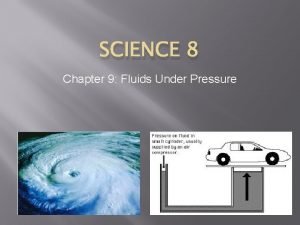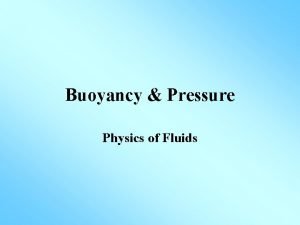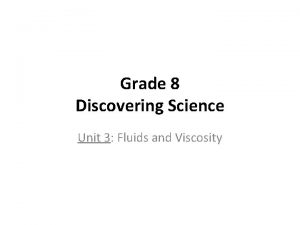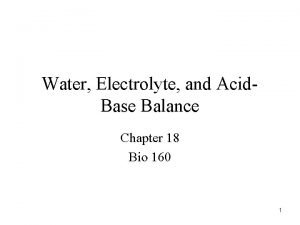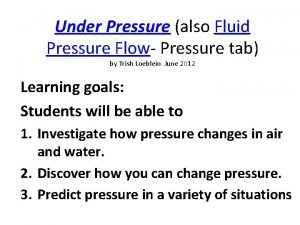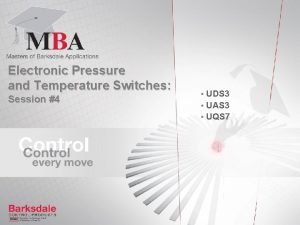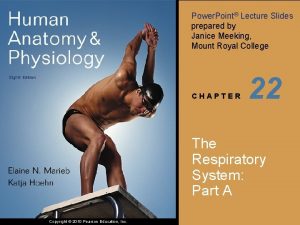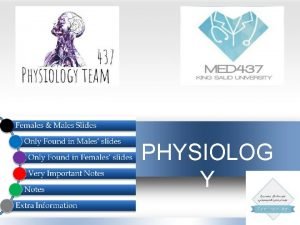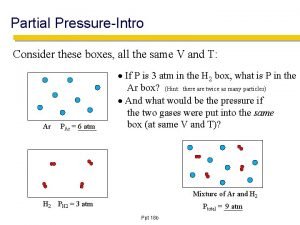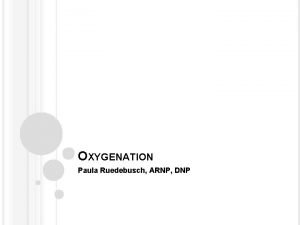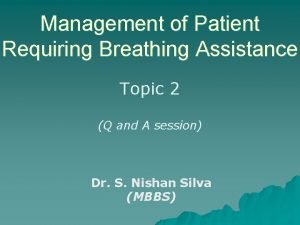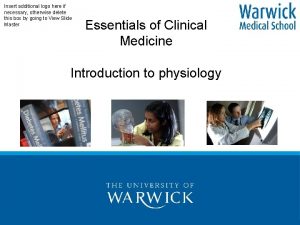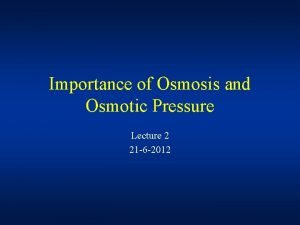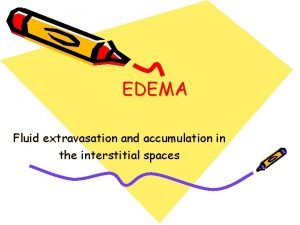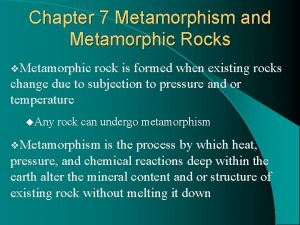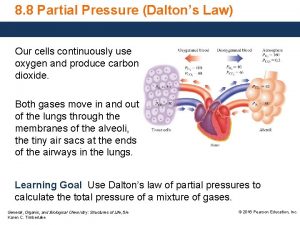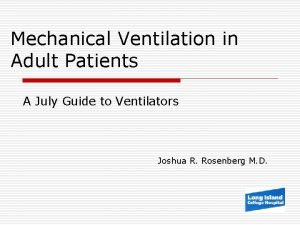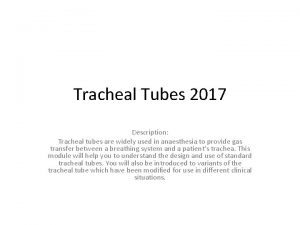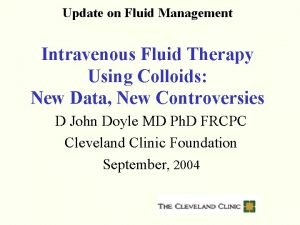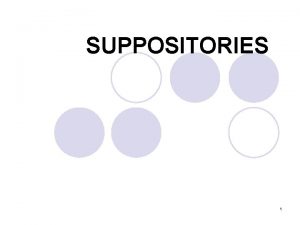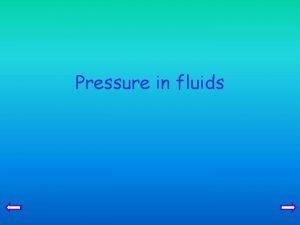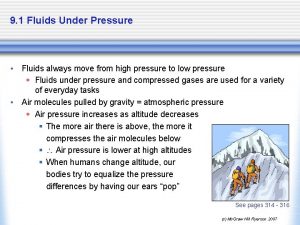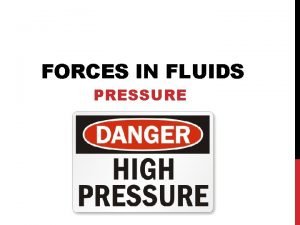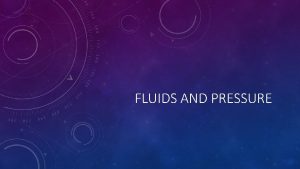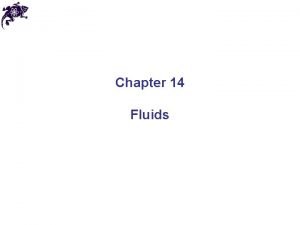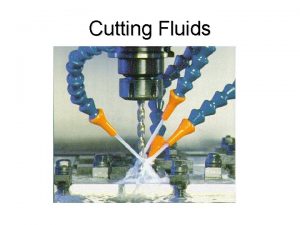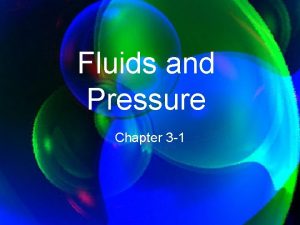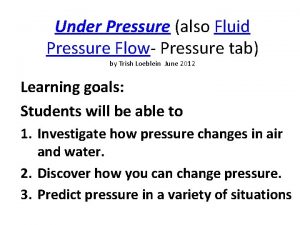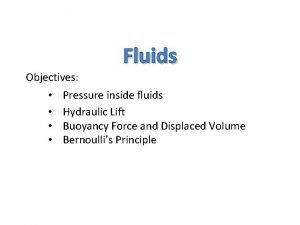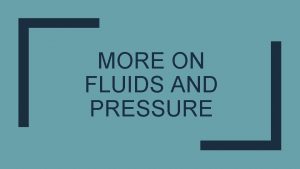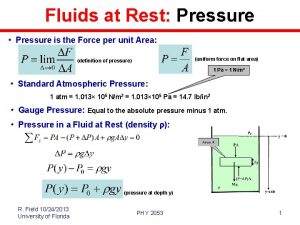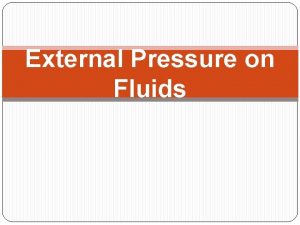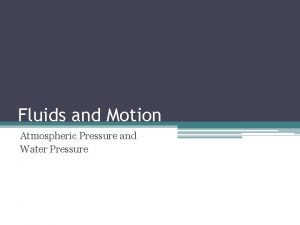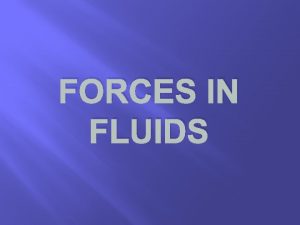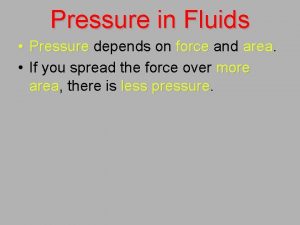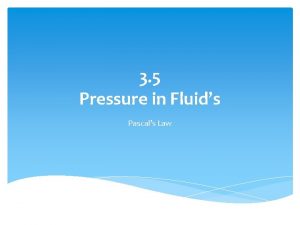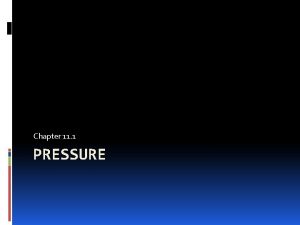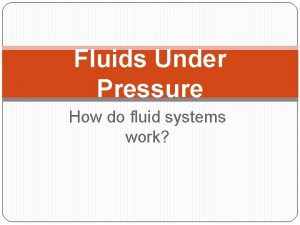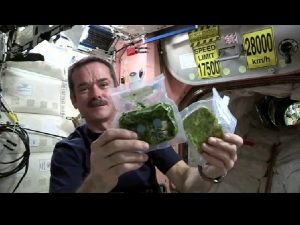SCIENCE 8 Chapter 9 Fluids Under Pressure 9































- Slides: 31

SCIENCE 8 Chapter 9: Fluids Under Pressure

9. 1 Fluids Under Pressure A Problem with a Natural Fluid System • Some infants are born with a condition known as hydrocephalus. • A normal brain has fluid surrounding it, this fluid cushions the brain. In hydrocephalic babies there is too much fluid surrounding the brain and the excess fluid creates an increase of pressure inside the skull, causing a bulging skull, seizures, and even brain damage.

Treatment for this Condition • Treatment = a tube is inserted in to the abdomen or another part of the body to drain the fluid. • A check valve in the tube helps ensure that the pressure in the brain is correct and the fluid does not flow in the wrong direction.

Fluids Under Pressure Daily Uses � � Fluids under pressure are used daily: Compressed gases Fire hoses Vacuum Cleaners Shocks Machines Liquids many not be compressible, but by placing them under pressure in confined places such as pipes, we can force them to go where we want.

Atmospheric Pressure � � Earth’s atmosphere is 160 km above us The layers of air exert pressure due to gravity Air pressure changes with altitude If there is a difference in pressure between the inside and out side of your ear drum then you will feel a “pop” as the pressure equalizes

Pressure Differences � � Fluids move from area of high pressure to are of low pressure When this happens we use this force to drive many different types of mechanical devices ex. Juice box, air hammer, etc.

Liquid Pressure of all fluids increases with depth � Atmospheric Pressure at sea level is 101. 3 k. Pa = one atmosphere or 1 Atm � Every 10 m down = pressure increases by 1 atmosphere �

Buoyancy � � = the tendency of objects to rise or sink due to the density differences between them and the surroundings Upward force exerted by a fluid = buoyant force Sinks—object exerts greater average force down Floats-- object exerts greater average force upwards

Rising and Sinking � � � Air heated will rise and expand; cooled it will condense and sink Convection is the vertical movement of fluids caused by density differences Cause heat is evenly distributed through out the earth

How the heating and cooling of water effects our wind patterns

Homework Textbook Questions Page# 323 Questions# 1 -5 ( number 6 is a bonus) Workbook pages 130 -133

9. 2 Constructed Fluid Systems � � Pressure in fluids at rest and in motion can produce a force to operate mechanical devices Hydraulic systems – create pressure that moves through a liquid Pneumatic systems – enclosed gases transmit force, causing motion Ex. Water pumps used during Hurricane Katrina

Fluids at Rest � � � Pascal – observed that when pressure is applied to one point in a fluid in an enclosed system, that pressure is transmitted equally throughout (Ex. Squeezing toothpaste) Squeezing an enclosed fluid creates static pressure (Ex. Car brakes)

Fluids in Motion � � A fluid in motion has dynamic pressure = energy to perform tasks It can also be used indirectly to perform tasks Speed of a fluid increases then pressure decreases (Ex. Airplane wing)

Hydraulic Systems � � � Hydraulics = study of pressure in liquids Hydraulic systems = devices that create pressure that moves a liquid Liquids are not compressible so if a pressure is exerted it travels through the liquid to perform a task somewhere else

Hydraulic Fluid Transportation � � Your water from your tap is always under pressure so that it will flow out when the tap is turned on It can come from a well in rural areas or in urban areas it will go through a water treatment plant where it is pumped to reach all areas of the system Pumps are important to hydraulic systems, so they can push water against gravity A simple example is a piston pump

Valves � � � An important part of a hydraulic system that controls the passage of fluid through a pipe is the valve Open = water flows Closed = water stops Check valve allows fluid to flow in only one way

Hydraulic Multiplication � � Mechanical systems can increase the force exerted on a fluid We can use this force to even lift a car

Problems in Hydraulic Systems � � � Pipe systems must be planned carefully so there is the least amount of resistance to flow Pressure is affected by pipe size and how smooth they are inside Water flow is affected by build-up in the pipes, corrosion, and mineral deposits

Pneumatic Systems � � � = the use of gas (usually air) in an enclosed system under pressure Like hydraulics except they use gas instead of liquid Pneumatic systems = gas transmits a force, causing motion Based on the fact that gasses can be compressed Using air compressors we can use many types of tools Pneumatics can be combined with hydraulic multiplication an example would be air brakes on large vehicles

Problems in Pneumatic Systems � � � There needs to be a difference in pressure between the inside of the machine and the air If it gets clogged up then the system no longer works, because the air can no longer escape Ex. A vacuum cleaner

Homework Textbook Questions Page 333 Questions# 1 -4, 6 Workbook pages 136, 138, 139

9. 3 Natural Fluid Systems � Natural fluid systems exist in the atmosphere, deep in the Earth, and in the oceans, as well as, inside humans

Fluid Systems in Humans � � Human body is about 66% water Water helps you to absorb food, transport nutrients, remove wastes, protects tissues, and maintains blood pressure

Circulatory System � � � Efficient natural hydraulic system = circulatory system Used to transport blood vessels are like pipes Pump = heart

Blood Pressure � � � � = the force of the blood on the walls of the blood vessels Special nerve cells can detect this change and send messages to your brain to speed up or slow down your heart Normal resting heart rates (60 -100 beats per minute) adult and (80 -100 beats per minute) children Typical reading for blood pressure would be 120/75 mm Hg First # = pressure from the blood leaving the heart Second # = pressure from the blood refilling the heart Blood pressure is measured using a sphygmomanometer

Disorders of Blood Circulation � � � Blood pressure is a good indicator to overall health High/Low blood pressure Ideal blood pressure is 120/80 Clogged arteries Smoking causes problems

The Respiratory System � � � Breathing is partly the result of changes in pressure Chest expands to create an area of low pressure so air rushes in This expansion is due to muscle groups between your ribs and your diaphragm

Disorders of Breathing � � � Clogged or swollen passageways affect natural systems Bacteria, viruses, and other micro-organisms can cause infections (colds, bronchitis, etc. ) and swelling occurs making it difficult to breathe Breathing smoke, pollution, coal dust, or asbestos can harm your respiratory system Asthma disease where air flow into lungs is altered Using an inhaler can help


Homework � Textbook Questions Page 343 Questions# 1 -5 Workbook 143, 145 (142 if done all other pages)
 Science 8- fluids under pressure worksheet answer key
Science 8- fluids under pressure worksheet answer key Buoyant force unit
Buoyant force unit Density particles
Density particles Chapter 18 fluids and electrolytes
Chapter 18 fluids and electrolytes Math is my favorite subject
Math is my favorite subject Under pressure tab
Under pressure tab Grahams law
Grahams law 000 budget scorekeepers are under pressure
000 budget scorekeepers are under pressure Faith under pressure
Faith under pressure U u u u under pressure
U u u u under pressure Insall salvati ratio
Insall salvati ratio Pressure support vs pressure control
Pressure support vs pressure control Continuous bedside pressure mapping
Continuous bedside pressure mapping Intrapulmonary pressure
Intrapulmonary pressure Oncotic vs osmotic
Oncotic vs osmotic Partial pressure formula
Partial pressure formula Intrapleural pressure
Intrapleural pressure Metamorphic grade
Metamorphic grade Sore throat after surgery
Sore throat after surgery Static pressure and dynamic pressure
Static pressure and dynamic pressure Oncotic vs hydrostatic pressure
Oncotic vs hydrostatic pressure Impermeance
Impermeance Low oncotic pressure
Low oncotic pressure Hydrostatic oncotic pressure
Hydrostatic oncotic pressure Metamorphism
Metamorphism Mean arterial pressure
Mean arterial pressure How to find partial pressure
How to find partial pressure Pressure support vs pressure control
Pressure support vs pressure control High pressure and low pressure
High pressure and low pressure Windkraft horizontalläufer
Windkraft horizontalläufer 4-2-1 rule
4-2-1 rule Types of bases in suppositories
Types of bases in suppositories
